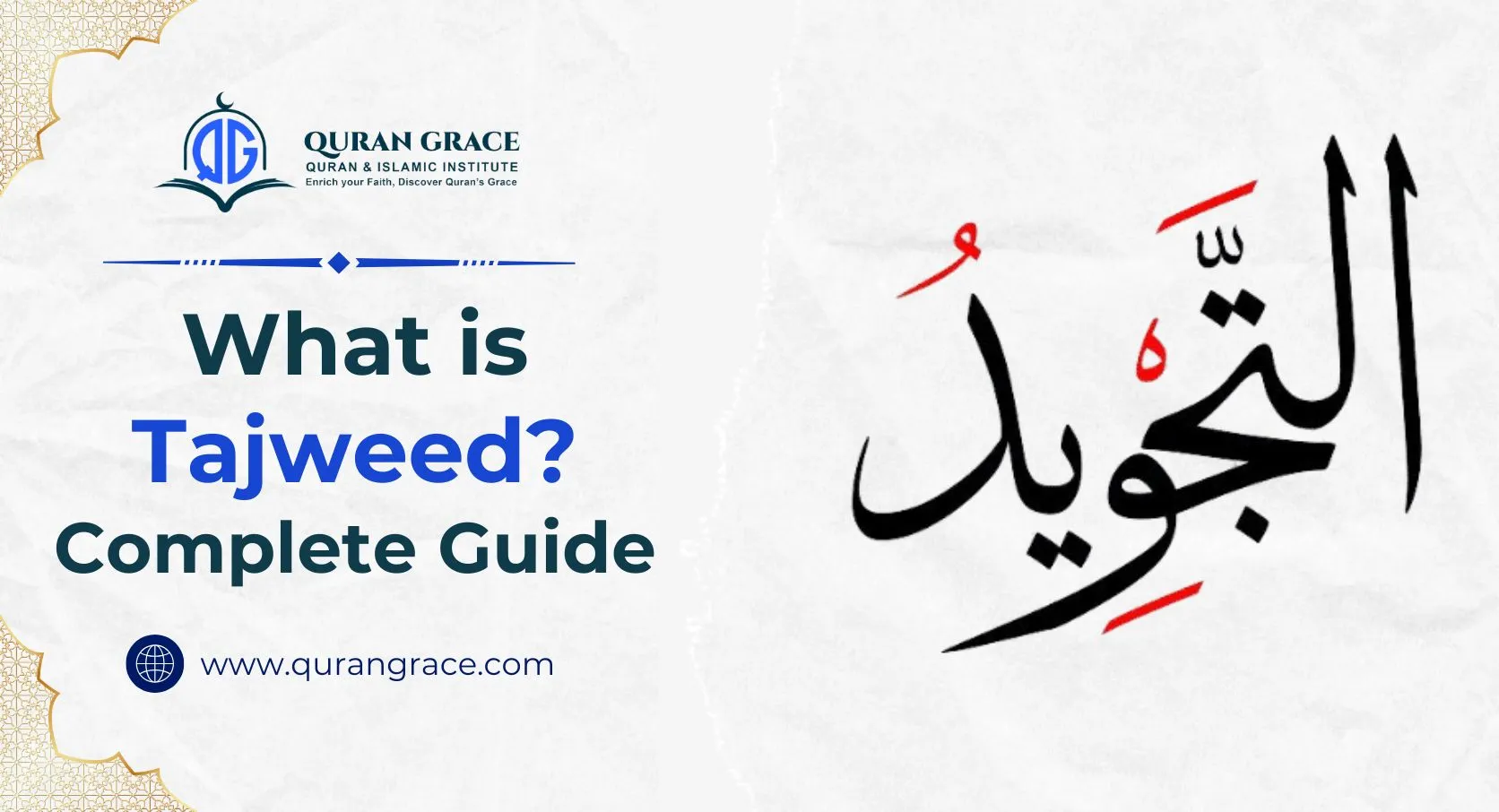Tajweed is a profound discipline that enriches the Quran recitation experience by connecting more deeply to Allah’s words. Learning tajweed helps pronounce the words of the Quran accurately, avoid mistakes during recitation, and strengthen the connection with verses. Learning tajweed rules helps the readers to learn how to recite quran property without mistakes.
Table of Contents
ToggleTajweed Meaning
The word tajweed is an Arabic word that means to “make better.”. It is the correct way of reciting the Quran. It covers the guidelines on how Arabic alphabets should be pronounced, places to pause, stop, or keep going during recitation, when to elongate the pronunciation of an alphabet, and so on. Reciting the Quran with proper tajweed helps to enhance the beauty and melody of the recitation.
Principles of Tajweed
1. Noon and Meem Moshaddadah
This rule applies to the letters noon (ن) and meem (م), which have a shaddah mark (نّ / مّ) with Ghunnah of two beats.
2. Al Qalqalah
This rule is put for the vibration in the sound at the end of the pronunciation of some letters: (ق), (ط), (ب), (ج), (د).
3. Noon Sakinah and Tanween
This rule is put for the letter noon (ن) with a sukoon (silent) mark. Tanween is the pronunciation of a noon sakinah at the end of a word, without writing it (اً). And it includes Izhaar, Idghaam, Iqlaab, and Ikhfaa.
4. Meem Sakinah
This rule applies to the letter meem (م), which bears a sukoon mark. And it includes Ikhfaa Shafawy, Idghaam Shafawy, and Izhar Shafawy.
5. Prolongation
It means giving the letter between two and six beats, depending on its type.
6. Heavy and light letters
The Arabic letters are classified into heavy and light letters according to the method of pronunciation. There are 7 heavy letters, while the rest of the letters are light.
7. Laam Shamsyiah & Qamaryiah (ل)
Laam Shamsiya and Laam Qamariya are like the sun and moon, guiding Arabic pronunciation. When Laam Shamsiya encounters one of the 14 “sun letters,” it blends in quietly, causing the next letter to shine brightly with double stress, such as “الشمس” (ash-shams).
In contrast, Laam Qamariya, facing 14 “moon letters,” retains its glow, clearly pronounced alongside the following letter, as in “القمر” (al-qamar).
8. Al Hamzah (أ)
There are two types of hamzah: Hamza-tul Oata’, which can appear at the beginning, middle, or end of a word. Hamzah-tul Wasl, which appears at the beginning of the words, is dropped when continuing.
9. Muldood
Muldood refers to the elongation of specific vowels in Arabic pronunciation, particularly Alif (ا), Ya (ي), and Waw (و). This elongation is denoted by a written symbol called Maddah placed over the respective letter.
10. Waqf and Ibtida (pause and start)
Waqf and Ibtida’ are important Tajweed rules that govern the pauses and starts when reciting the Quran. Waqf involves knowing when to pause at specific points within the Quranic text, while Ibtida’ dictates where to begin recitation.
11. Sifaat-al-Huroof
Sifaat al-Huroof is an important rule of Tajweed that reveals the intricate characteristics of each letter in the Arabic language. Each letter is more than just a symbol; it carries specific attributes that dramatically influence how it sounds. For instance, consider the concepts of heaviness (tafkheem) and lightness (tarqeeq). These qualities not only affect pronunciation but also enrich the beauty and rhythm of spoken Arabic. Additionally, elongation (madd) plays a crucial role in extending sounds for clarity and emphasis.
12. Makharij-al-Huroof
Makharij al-Huroof, often translated as the “points of articulation,” is a crucial rule/concept in Tajweed. These points denote the specific places where Arabic letters originate in the mouth and throat.
A thorough understanding of Makharij al-Huroof is essential for accurate Quranic recitation, as each letter’s pronunciation is determined by its point of origin.
How to Improve Your Tajweed?
If we have a basic understanding of Tajweed, it will still take some practice to become acquainted with it. Here are some tips to help you improve your Tajweed.
1. Focus on your pronunciation
You must first understand the letters, their sounds, and pronunciation, as this will greatly aid in effective recitation. As a result, you must first learn the sounds of Arabic letters to properly mix them in later lessons.
2. Focus on your tone
The intonation (rise and fall) of your tone, as well as how you project voice/sound, are both important. To improve your recitation, you must learn and understand when to increase volume, slow down, and silence.
3. Master Waqf and other signs
When reading the Quran, we should understand the meaning of each sign, as they are also part of Tajweed. So, in addition to correct pronunciation and intonation, it is important to pay attention to stop, continue, and pause signs because they affect the meaning of the verse.
4. Get Help From a Professional
Online tajweed course can help you not only improve your Tajweed but also perfect it. You can get help from a qualified egyptian quran teacher Tajweed rendered by any reliable online Quran learning platform like Quran Grace.
Importance of Tajweed
To understand the importance of Tajweed, you must realize that reading the Holy Quran is not like reading any other book. So we must recite the Quran correctly as it should be. That’s why the knowledge of Tajweed is Fard Kifayah (a communal obligation) upon all Muslims, kids or adults, male or female, to learn.
Another reason that makes Tajweed very important is preserving the Quran as well as the Arabic language from distortion across time. Arabs interacted with non-Arabs after the spread of Islam. Muslims feared that the Arabic language, the language of the Quran, would be corrupted. As a result, it became critical to follow Tajweed regulations to keep the Quran recitation free of faults and to ensure the reader of the Quran’s pronunciation integrity.
Moreover, learning Tajweed will not only help you master Quran recitation but excel in learning Arabic as well. When you listen to Quran recitation with Tajweed, you feel like your heart is melting in the love of Allah & Quran. The beautifying of voices while reciting the Quran is also mentioned in one of the hadiths “Make your voices beautiful when you recite Quran.” (Sunan an-Nasa’i 1015)
“Make your voice beautiful when you recite the Quran.”
Conclusion
Learning and mastering the rules of Tajweed can easily be done from the convenience of home in your leisure time through Quran Grace Academy, which offers multiple courses for Tajweed for different age groups. Take a free trial and enroll in the most suitable online quan recitation course to read and recite the Quran the way Arabs do.








